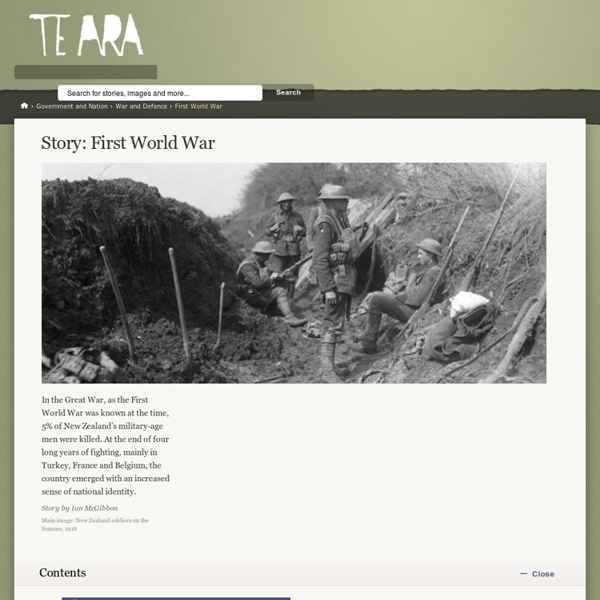Australian War Memorial
Anzac Diversity Collection Anzac Diversity is a collection of case studies exploring the ethnic diversity of the Australian Imperial Force (AIF). Anzac Diversity Anzac Diversity is a collection of case studies exploring the ethnic diversity of the Australian Imperial Force (AIF).
In the trenches of 1914-1918
What were the trenches? Although most of us think primarily of the Great War in terms of life and death in the trenches, only a relatively small proportion of the army actually served there. The trenches were the front lines, the most dangerous places. But behind them was a mass of supply lines, training establishments, stores, workshops, headquarters and all the other elements of the 1914-1918 system of war, in which the majority of troops were employed. The trenches were the domain of the infantry, with the supporting arms of the mortars and machine-guns, the engineers and the forward positions of the artillery observers.
Build your First World War school programme - Education - Auckland War Memorial Museum
One Hundred years on from the First World War: 2014 – 2018 We provide a wide range of educational opportunities to help engage students with the events of the First World War. These include onsite educator led programmes, onsite independent programmes and gallery links, competitions and more.
The Gallipoli campaign - The Gallipoli campaign
Each year on Anzac Day, New Zealanders (and Australians) mark the anniversary of the Gallipoli landings of 25 April 1915. On that day, thousands of young men, far from their homes, stormed the beaches on the Gallipoli Peninsula in what is now Turkey. For eight long months, New Zealand troops, alongside those from Australia, Great Britain and Ireland, France, India, and Newfoundland battled harsh conditions and Ottoman forces desperately fighting to protect their homeland. By the time the campaign ended, more than 130,000 men had died: at least 87,000 Ottoman soldiers and 44,000 Allied soldiers, including more than 8700 Australians. Among the dead were 2779 New Zealanders, about a fifth of all those who had landed on the peninsula. In the wider story of the First World War, the Gallipoli campaign made no large mark.
First War War Poetry
The First World War Poetry Digital Archive is an online repository of over 7000 items of text, images, audio, and video for teaching, learning, and research. The heart of the archive consists of collections of highly valued primary material from major poets of the period, including Wilfred Owen, Isaac Rosenberg, Robert Graves, Vera Brittain, and Edward Thomas. This is supplemented by a comprehensive range of multimedia artefacts from the Imperial War Museum, a separate archive of over 6,500 items contributed by the general public, and a set of specially developed educational resources. These educational resources include an exciting new exhibition in the three-dimensional virtual world Second Life.
The Anzac landing at Gallipoli
The Anzac landing: overview Why did theAnzacs land? 25 April 1915: Anzac Cove, Gallipoli Historians still debate whether the Anzac troops were landed at the correct place.
History of Anzac Day
Anzac Day 1916-22: The making of a holy day 25 April 1922 was a day of mourning throughout New Zealand. In cities and towns a sombre and almost surreal stillness reigned unlike any other day of the year.
Digital Collection - NZ
You are here: Home > Digital Collection > Wars & conflict Heritage Digital Collection Home
How many New Zealanders served on Gallipoli?
As the centenary of the First World War approaches, people are interested in how many Kiwis served in the various campaigns. For Gallipoli, the answer is not straightforward – and the waters have been muddied by a mistake by a senior British general that went unnoticed for nearly a century. Sir Ian Hamilton was a respected military thinker but not a great success as head of the Mediterranean Expeditionary Force (MEF), the cobbled-together Allied army which began landing on Turkey’s Gallipoli Peninsula on 25 April 1915. I’ve recently realised that Hamilton was also responsible for a significant underestimate of the number of men who served on Gallipoli in New Zealand units of the MEF. Sir Ian Standish Monteith Hamilton. Library of Congress, LC-DIG-ggbain-18025.
Battle of Gallipoli - World War I
With World War I stalled on the Western Front by 1915, the Allied Powers were debating going on the offensive in another region of the conflict, rather than continuing with attacks in Belgium and France. Early that year, Russia’s Grand Duke Nicholas appealed to Britain for aid in confronting a Turkish invasion in the Caucasus. (The Ottoman Empire had entered World War I on the side of the Central Powers, Germany and Austria-Hungary, by November 1914.) In response, the Allies decided to launch a naval expedition to seize the Dardanelles Straits, a narrow passage connecting the Aegean Sea to the Sea of Marmara in northwestern Turkey. If successful, capture of the straits would allow the Allies to link up with the Russians in the Black Sea, where they could work together to knock Turkey out of the war.



